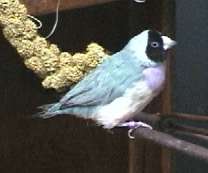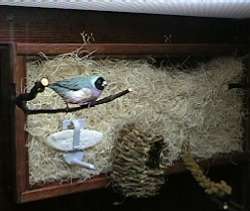|
PERSONAL
STUFF
|
||
|
|
About Us - A little information about us. Dedication - The story of Amelia, the lost Lady Gouldian, to whom we dedicate this site. |
|
|
This site is dedicated to a Lady Gouldian hen named Amelia. We had thought she was a black-headed normal, but I've recently been informed bySandy at Littlebirds: Pages on the Gouldian Finch that she was actually a black-headed blue-backed hen. Thank you, Sandy, for sharing that information with us.
Amelia was rescued on the loose in downtown Chicago by a vacationing couple on July 31, 2000. She was lying on the ground on the verge of death. Wild crows were eyeing her as a potential supper. When the couple attempted to catch her, she had a little flight left in her but not much sense of direction, and she flew into a wall, after which they were able to catch her and bring her into the warmth.
The couple contacted a finch breeder they found on the web, not knowing he no longer lived in the area. He and Tom had been coworkers and he knew we kept finches, so he gave the couple Tom’s work number. Tom drove downtown to pick her up.
Amelia was NFSS closed banded in 1997, making her somewhere in the vicinity of 3 years old. We kept her in a spare cage we had for transporting and hospitalizing finches. She was in bad shape and I didn’t believe she would last through the night. She suffered from symptoms that resembled a very severe case of Twirling.
Twirling is something of a mystery. There are many theories as to its cause and conflicting reports about whether it is curable or treatable. It is possible that there are many causes that produce the same symptoms, some of which are treatable and others are not. But anyone who has ever seen a bird presenting with these symptoms know that it is one of the saddest conditions a bird can be in.
Amelia could not lift her head up off the ground. She had no sense of balance and she could not perch. For the most part, her head hung upside down beneath her, and when she tried to fly, she mostly flayed about on the floor. In spite of this disability, when presented with food, she was able to stick her head in the dish sidewise and husk seeds or eat veggies. In fact, among Gouldians, she was the best eater I have ever had, trying anything offered to her.
Somehow, she made it through the night. I made an appointment with our avian vet, took off from work, and brought her in. Turned out, in addition to the Twirling, she had feather mites. A blood test showed fat cells in her blood. The levels were not so high as to be critical, but we were warned that this could be a sign of liver problems (if I remember correctly).
The doctor said the Twirling could be caused by many different things. Some people believe Twirling is a genetic trait common to gouldians, possibly caused by an inability to absorb vitamins and minerals efficiently. If not given high enough levels of these nutrients, the trait would express itself. The doctor said the Twirling could be caused by a virus, possibly caught from an infected pigeon she encountered in the wild, since pigeons seem to be prone to this type of virus. He also said it could be caused by an inner ear infection. The infection throws their equilibrium system off and they have difficulty holding their head up.
She was both dusted with Ivermectin and also given a shot of Ivermectin to kill all stages of the mites. In an attempt to treat the Twirling (as well as any other infections she may have had), she was given an antibiotic injection and we were given a prescription for Vetisulid (a broad-spectrum antibiotic) and Probios, a probiotic to restore the gut flora diminished by the antibiotic. The total cost of the visit and the medications came to $98.54.
That night we had an awful time. We had given her water in a very shallow dish (about 1/2” tall) and put it on the floor of the cage where she could easily reach it, since she could not perch to reach the food and water dishes that came with the cage. She somehow fell in the water dish (possibly in a bout of night-fright) and was flapping around madly. It looked like she was having a very bad seizure, but it could have been that she just fell in and was unable to get out again. I grabbed her and dried her off with a towel and put her back in the cage with an added source of heat from a ceramic heat lamp. I then called Bird 911 (the after-hours bird and small-animal emergency hotline), but was told that there was nothing more I could do for her. To our relief, she survived the incident.
We learned after that incident that Amelia was particularly prone to night fright. Night fright occurs when a bird suddenly startles badly in the middle of the night. They flutter about madly in the dark and crash into the walls of the cage/aviary. To help her through the night frights we left a dim light on all night in her room.
For several days we noticed no improvement in Amelia. But after about two weeks of antibiotic treatment, things began to change. It seemed to us that Amelia could do a better job of lifting her head, at least for brief moments. Then she began to perch, even though her head still hung upside down below her belly. Gradually her head straightened out more and more so that it was mostly erect except for occasional twitches. She began to sleep with her head tucked under her wing like the other birds. She began to fly from perch to perch.
She was now so much healthier that we knew we had to give her a larger living quarters. The vet advised us against moving her in with the other birds because she could still be carrying a number of illnesses that lay dormant. So Tom went to work on building her a flight. The final flight was a little more than 4 ft long, 2.5 ft deep and 3 ft tall. She loved it. She flew from perch to perch and peeped all day long.
I believe Amelia was very happy for several months. Then one night in November, we noticed a strange behavior change. She would sit on the perch where she slept and make the hissing sound that Gouldians make when they are angry or defending their territory. We decided not to disturb her. In the morning, we found her dead at the bottom of the flight.
I believe she had finally succumbed to the liver problems the vet had suggested she might have when he did the blood test. I had noticed that her urates were slightly yellow and lately she had been excreting lumpy droppings that looked like they might have contained undigested millet from the millet spray. In spite of this, her death hit us hard. We had hoped that she could spend the rest of a long life in luxury and peace. She had had a rough time and she deserved this much. But it wasn’t meant to be. I do believe that the four months she spent with us were happy months for her. It just wasn’t long enough.
Click
Previous to return to the About Us Page |
|
The
images on this page are of poor quality because they are screen
captures of video taken with our camcorder.
|
HOME
| CONSTRUCTION
| CARE
| BIRDS | ACCESSORIES
| BACKGROUND
AVICAM | GALLERY
| GUESTBOOK | LINKS
| SEARCH
SITE MAP | DISCLAIMER
| CONTACT US
(c)2004 FinchAviary.com
 Dedication
Dedication When
we took her to the vet for her follow-up appointment, she was
a completely different bird. Even the vet was surprised at the
degree of her improvement. She was given a follow-up dose of
Ivermectin even though no signs of feather mites remained.
When
we took her to the vet for her follow-up appointment, she was
a completely different bird. Even the vet was surprised at the
degree of her improvement. She was given a follow-up dose of
Ivermectin even though no signs of feather mites remained.